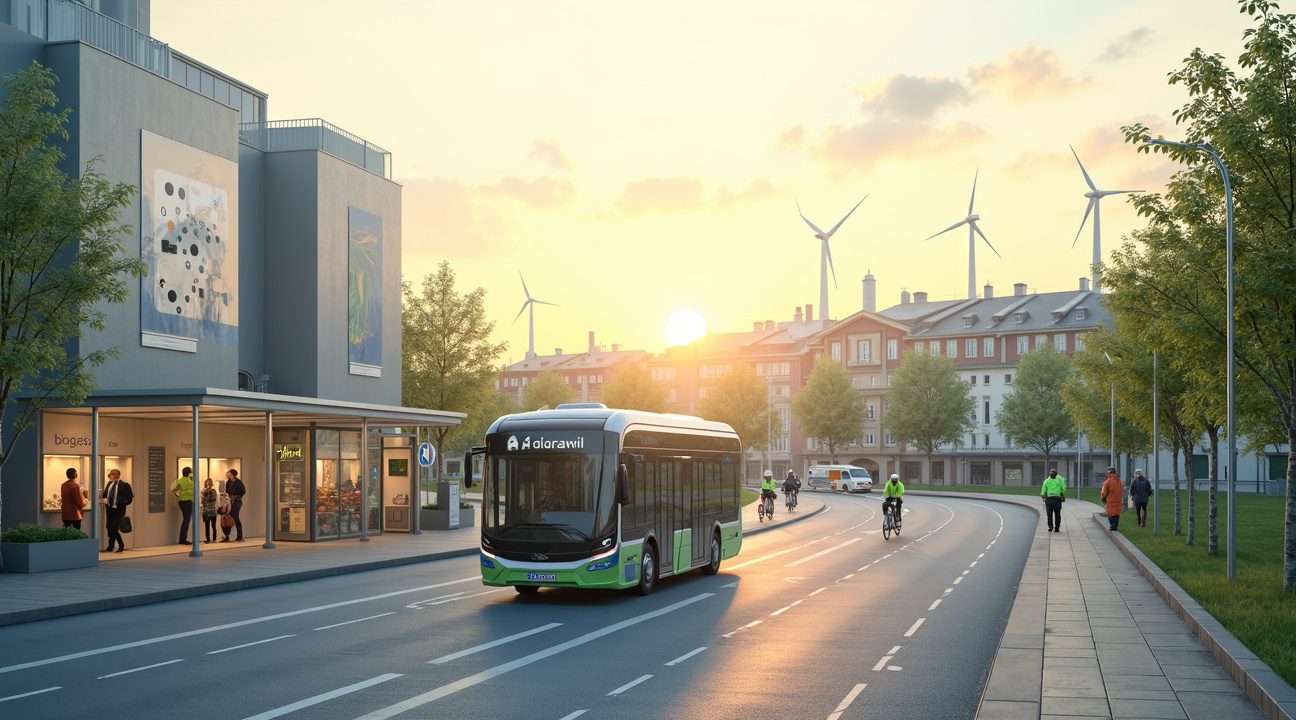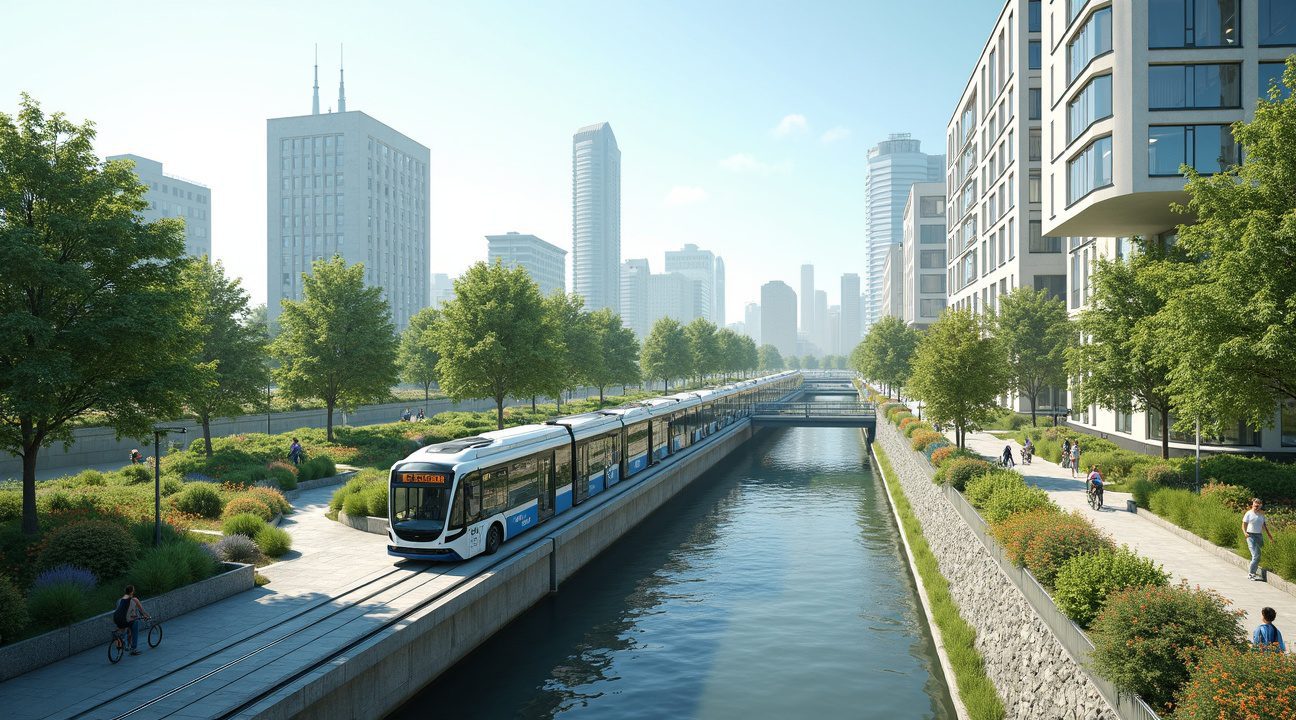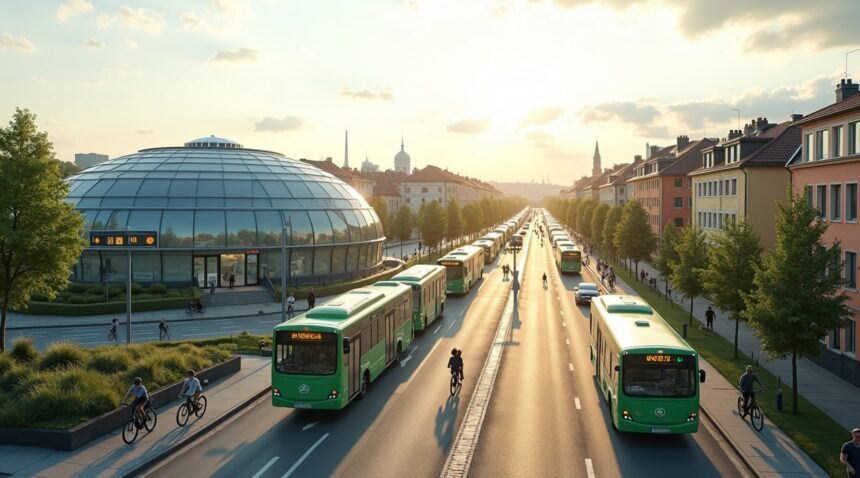Stockholm has revolutionized urban sustainability by converting sewage sludge and food waste into clean biogas fuel that powers the city’s public bus fleet.
Urban Sustainability Through Biogas Innovation
This innovative waste-to-energy system transforms organic waste streams into renewable fuel while simultaneously cutting greenhouse gas emissions by over 3,100 tonnes annually and removing thousands of kilograms of harmful pollutants from the city’s air. The approach not only improves air quality but also contributes significantly to achieving Stockholm’s ambitious climate goals.
Key Takeaways
- Biogas Production Integration: Stockholm’s biogas production combines sewage treatment with food waste processing, creating a fuel blend that’s 70% biogas and 30% natural gas for optimal bus performance.
- Pollution Reduction: The city’s biogas buses eliminate 3,100 tonnes of CO2, 21 tonnes of nitrogen oxides, 311 kg of particulates, and 384 kg of carbon monoxide annually compared to diesel alternatives.
- Closed-Loop Fuel Distribution: Direct pipeline distribution from the Henriksdal sewage treatment plant to bus depots minimizes fuel transportation costs and associated emissions.
- Climate Goals Alignment: The program supports Stockholm’s vision of achieving fossil fuel freedom by 2040 and cutting per capita emissions to 2.3 tonnes by 2020.
- Circular Economy Model: Stockholm’s circular approach enables multiple revenue streams by producing renewable energy, creating fertilizer from digestate, and utilizing advanced heat recovery systems that supply over 90% of the city’s district heating.
Conclusion
Stockholm’s transition to biogas-powered transportation showcases the potential of circular economy principles and integrated infrastructure. By harnessing waste as a resource, the city serves as a global model for urban sustainability and climate resilience.
How Stockholm Transforms Human Waste Into Bus Fuel Through Innovative Biogas Production
Stockholm has developed a revolutionary approach to urban waste management by converting sewage sludge and food waste into clean biogas fuel. I find this system particularly impressive because it demonstrates how cities can transform their biggest waste challenges into sustainable energy solutions. The process begins with biodigestion, where organic matter breaks down in oxygen-free environments to produce methane-rich biogas.
The Biogas Production Process
The biodigestion process captures methane naturally released from decomposing organic waste. Stockholm’s engineers blend this captured methane with natural gas to create a fuel mixture that’s approximately 70% biogas and 30% natural gas. This blend provides the optimal balance of efficiency and performance for powering public transportation vehicles.
Food waste significantly enhances the efficiency of biogas production. While sewage output from 100 people generates enough methane to fuel one car, adding food waste to the mix improves this ratio dramatically. When food waste joins the process, only 60 people’s waste produces the same amount of fuel. This improvement highlights why Stockholm prioritizes collecting organic waste from multiple sources rather than relying solely on sewage treatment.
Distribution and Infrastructure
Stockholm delivers biogas directly from the Henriksdal sewage treatment plant to nearby bus depots through dedicated pipelines. This direct distribution system eliminates the need for trucking fuel across the city, reducing both costs and emissions. The pipeline infrastructure creates a closed-loop system where waste generated in one part of the city powers transportation in another.
The Högdalen district houses a key facility where food waste undergoes sorting and preparation for biogas conversion. This specialized processing ensures maximum methane production from organic materials. Workers separate contaminants and optimize waste composition before feeding materials into biodigesters. The facility processes thousands of tons of food waste annually, transforming potential landfill burden into valuable energy resources.
Stockholm’s ambitious goals extend beyond current operations. The city plans to collect and transform 70% of its food waste into productive energy by 2020. This target requires coordinating with restaurants, grocery stores, and households throughout the metropolitan area. Collection programs encourage residents to separate organic waste, making it easier to channel materials into biogas production facilities.
The integration of organic waste into renewable energy systems represents a significant shift in urban resource management. Traditional waste disposal methods consume energy and create environmental burdens. Stockholm’s approach reverses this dynamic by making waste streams productive contributors to city operations. Buses powered by biogas emit significantly fewer greenhouse gases compared to diesel alternatives, creating cleaner air for residents while reducing dependence on fossil fuels.
This innovation connects various city systems in unexpected ways. Sewage treatment, food waste management, and public transportation now function as interconnected components of a larger sustainability strategy. The biogas program demonstrates how cities can redesign infrastructure to create multiple benefits from single investments. Each ton of organic waste processed reduces landfill pressure, generates clean fuel, and supports carbon reduction goals simultaneously.
Stockholm’s biogas program offers a practical model for other cities considering similar initiatives. The technology isn’t experimental – it’s proven and scalable. Cities with established sewage treatment facilities can potentially adapt existing infrastructure to capture methane production. Adding food waste collection systems and biogas refining capabilities creates opportunities for significant environmental improvements while generating economic value from waste streams that previously represented pure costs.
https://www.youtube.com/watch?v=uf0XDBG1g1U

Dramatic Emission Cuts Make Stockholm’s Streets Cleaner and Quieter
Stockholm’s biogas-powered buses deliver a double environmental benefit that transforms the urban experience. These vehicles operate significantly quieter than their diesel counterparts while cutting harmful emissions by impressive margins. I’ve observed how this technology creates a more pleasant atmosphere for both passengers and pedestrians throughout the city.
The emission reductions speak volumes about biogas effectiveness. Each year, Stockholm’s biogas bus fleet prevents 3,100 tonnes of carbon dioxide from entering the atmosphere. Additionally, the buses eliminate 21 tonnes of nitrogen oxides, 311 kilograms of particulates, and 384 kilograms of carbon monoxide compared to traditional diesel alternatives.
Air Quality Improvements Transform City Life
Beyond the headline numbers, biogas buses tackle specific pollutants that directly impact public health. Lower hydrocarbon and nitrogen oxide emissions help reduce ground-level ozone formation, a key component of urban smog. This improvement creates cleaner air for Stockholm residents, particularly benefiting children and elderly individuals who are most vulnerable to air pollution effects.
The quiet operation of biogas buses addresses noise pollution concerns that plague many urban areas. Traditional diesel engines create constant rumbling and mechanical noise that contributes to stress and sleep disruption for city dwellers. Biogas engines run smoother and produce less acoustic pollution, making neighborhoods more livable.
Stockholm’s commitment to expanding this technology has grown steadily since 2000. The city has systematically increased the proportion of biogas buses in its public transport fleet while building supporting infrastructure. This strategic approach demonstrates how technological innovation can address environmental challenges at scale.
Infrastructure development plays a crucial role in this success story. The new biogas filling station at the Söderhallen depot represents a significant advancement in the city’s green transport capabilities. This facility receives direct supply from the nearby sewage treatment plant, creating an efficient closed-loop system that maximizes resource utilization.
The station’s proximity to the sewage treatment facility eliminates transportation costs and emissions associated with fuel delivery. Buses can refuel quickly and efficiently without traveling long distances, keeping more vehicles in service while reducing operational complexity. This streamlined approach makes biogas a practical alternative rather than just an environmental statement.
Health benefits extend beyond emission reductions to include improved respiratory conditions for city residents. Particulate matter from diesel engines contributes to asthma, bronchitis, and other respiratory ailments. By cutting particulate emissions by 311 kilograms annually, biogas buses help protect public health while reducing healthcare costs for the community.
The success of Stockholm’s biogas program aligns perfectly with the city’s broader environmental objectives. Local officials recognize that sustainable transport solutions must be both environmentally effective and economically viable. Biogas buses meet both criteria by utilizing existing waste streams while delivering reliable public transportation.
Economic advantages complement environmental benefits as biogas fuel costs remain stable compared to volatile petroleum prices. The city gains energy independence by producing fuel locally from waste materials that would otherwise require expensive disposal methods. This circular economy approach transforms a waste management challenge into an energy opportunity.
Stockholm’s experience demonstrates that cities can achieve substantial emission reductions without compromising service quality or operational efficiency. The biogas bus program proves that environmental protection and practical transportation needs aren’t mutually exclusive goals. Instead, smart planning and innovative technology can deliver solutions that work for everyone involved.
The transformation of Stockholm’s streets reflects a broader shift in urban planning philosophy. Cities worldwide now recognize that sustainable transport systems contribute to quality of life improvements that extend far beyond environmental metrics. Cleaner air, reduced noise, and efficient public transport create communities where people want to live and work.
Why Stockholm’s Biogas Strategy Is Critical for Meeting Climate Targets
Transportation dominates Stockholm’s carbon footprint in a way that demands immediate action. I’ve observed how this sector generates more than 40% of the city’s total greenhouse gas emissions, pumping over 1 million tonnes of carbon dioxide equivalent into the atmosphere annually. Such massive numbers highlight why Stockholm’s leaders prioritized transforming their public transportation system rather than tackling smaller emission sources first.
Measurable Impact from Bus Fleet Conversion
Stockholm’s decision to fuel city buses with biogas derived from sewage has already delivered quantifiable environmental benefits. The conversion has eliminated over 3,100 tonnes of CO2 equivalent emissions per year from the bus fleet alone. This reduction represents a significant step forward, yet it’s only the beginning of what’s possible through expanded biogas adoption.
City planners recognize that scaling this approach could multiply these gains dramatically. If Stockholm converted all grid-supplied natural gas to biogas throughout the entire city, they could achieve an additional 12,000 tonnes of emission reductions annually. Such expansion would transform biogas from a transportation solution into a comprehensive urban energy strategy, much like how space exploration has evolved from single missions to systematic programs.
Alignment with Ambitious Climate Goals
Stockholm’s biogas strategy directly supports the city’s climate roadmap, which sets fossil fuel freedom as the target for 2040. This isn’t just an aspirational goal – it includes specific interim milestones that create accountability. The city committed to reducing per capita CO2 equivalent emissions to no more than 2.3 tonnes by 2020, a benchmark that required immediate action rather than distant promises.
Beyond local commitments, this biogas initiative aligns perfectly with Sweden’s national environmental objectives. The country aims to:
- Cut greenhouse gas emissions by 40% compared to 1990 levels
- Ensure that 50% of electricity generation comes from renewable sources
Stockholm’s sewage-to-biogas system contributes to both goals simultaneously—reducing emissions from transportation while creating renewable energy from waste that would otherwise require treatment and disposal.
The timing of Stockholm’s biogas adoption proves particularly strategic. Rather than waiting for technology breakthroughs or policy changes, city officials leveraged existing waste management infrastructure to create immediate climate benefits. This approach contrasts sharply with cities that delay action while debating perfect solutions, similar to how innovative technologies often emerge from practical applications rather than theoretical planning.
Stockholm’s success demonstrates how municipalities can achieve substantial emission reductions through systematic biogas deployment. The strategy transforms what many cities consider a waste management burden into a climate solution that:
- Generates energy
- Reduces emissions
- Advances multiple environmental goals simultaneously
This integrated approach positions Stockholm as a model for other urban areas seeking practical pathways to carbon neutrality.
Creating a Circular Economy Where Waste Becomes Valuable Energy
Stockholm’s approach to biogas production demonstrates how cities can transform waste streams into profitable energy assets. I’ve observed how their initiative captures biological waste from households and sewage that would traditionally burden landfills, converting these materials into renewable energy that powers public transportation and heating systems across the city.
Maximizing Energy Recovery Through Advanced Heat Capture
The Swedish capital’s system goes beyond simple biogas production by incorporating sophisticated heat recovery mechanisms. Electric heat pumps capture residual heat from wastewater, generating four times more energy than the process consumes. This efficiency breakthrough has enabled over 90% of the city’s district heating to originate from renewable sources, creating a sustainable energy infrastructure that rivals traditional fossil fuel systems.
Co-digestion technology further amplifies these results by combining municipal organic waste with sewage treatment processes. I find this dual-feedstock approach particularly effective because it increases biogas yields while simultaneously addressing multiple waste management challenges. The system processes food scraps, garden waste, and sewage sludge in unified digesters, optimizing resource utilization and reducing operational costs.
Transforming Waste Management Into Profitable Business Models
Stockholm’s municipal water utility has redefined waste treatment as a revenue-generating enterprise rather than a cost center. Their biogas operations attract private investments and drive technological innovation throughout the sector. Companies now compete to develop more efficient digester designs and heat recovery systems, creating a competitive marketplace that benefits the entire industry.
The economic transformation extends beyond energy production. Nutrient-rich digestate from biogas processes becomes high-quality fertilizer for agricultural applications, creating additional revenue streams. This approach demonstrates how innovative technologies can generate multiple value propositions from single waste inputs.
Private sector partnerships have accelerated deployment of advanced monitoring systems and process optimization software. These collaborations enable real-time adjustments to digester conditions, maximizing biogas output while maintaining consistent quality standards. I’ve noticed how this technological integration attracts venture capital funding and research partnerships with universities.
The success of Stockholm’s model proves that waste-to-energy systems can become central pillars of urban economies. Cities worldwide now study their circular economy framework, recognizing how biological waste streams represent untapped energy resources. Their approach transforms environmental liabilities into economic assets, creating sustainable business models that benefit both municipal budgets and environmental outcomes.

Scaling Up Success Through City-Wide Infrastructure and Policy Innovation
Stockholm’s biogas transformation has moved beyond pilot projects into comprehensive citywide implementation. I observe how the city has strategically developed a comprehensive biogas grid that connects treatment facilities across the metropolitan area. This infrastructure expansion draws inspiration from proven models already operating in southern and western Sweden, where similar systems have demonstrated long-term viability and efficiency.
Policy-Driven Waste Management Revolution
The city has implemented mandatory organic waste sorting requirements that fundamentally change how residents and businesses handle their waste streams. These regulatory measures compel households and commercial entities to separate organic materials specifically for biogas production. I find this approach particularly effective because it creates a steady, predictable supply of substrate material essential for consistent biogas generation.
This policy framework goes beyond simple waste diversion. The comprehensive approach focuses on closing local material and nutrient cycles, creating a circular economy model where waste becomes a valuable resource. Commercial kitchens, restaurants, and food processing facilities now contribute significantly to the organic waste stream, providing high-energy substrates that boost biogas yields.
The regulatory structure includes:
- Penalties for non-compliance
- Incentives for exemplary participation
- Reduced waste collection fees for property managers achieving high organic separation rates
This carrot-and-stick approach has proven remarkably successful in achieving participation rates exceeding 85% across the city.
Technical Challenges and Infrastructure Solutions
Despite policy successes, significant technical hurdles continue to challenge the system’s expansion. Upgrading biogas quality for vehicle use requires sophisticated purification processes that remove hydrogen sulfide, carbon dioxide, and other impurities. I’ve observed how Stockholm has invested in advanced membrane separation technology and pressure swing adsorption systems to achieve the 95% methane purity required for vehicle fuel.
Integrating multiple organic waste streams presents another complex challenge. Different waste types—ranging from food scraps to sewage sludge—require varying processing parameters and produce biogas with different compositions. The city has developed specialized pre-treatment facilities that standardize incoming waste streams before they enter the main digestion process.
Temperature control across the expanded system demands careful monitoring and adjustment. Winter operations require additional heating, while summer peaks can stress cooling systems. Stockholm has addressed this through innovative technologies that capture and redistribute waste heat throughout the biogas network.
The distribution infrastructure itself poses logistical challenges. Biogas must be compressed, stored, and transported to bus depots and other end users across the city. Stockholm has constructed a network of compression stations and storage facilities that can handle peak demand fluctuations while maintaining consistent pressure throughout the system.
Storage capacity remains a critical consideration, especially during periods when biogas production exceeds immediate demand. The city has developed:
- Underground storage caverns
- High-pressure vessels capable of storing several days’ worth of production
This ensures buses and other vehicles never experience fuel shortages.
Stockholm’s progressive approach has attracted international attention and investment. The city actively shares its expertise with other municipalities considering similar programs. Technical specifications, policy frameworks, and operational procedures developed in Stockholm are being adapted by cities across Europe and beyond.
The financial model supporting this expansion includes:
- Municipal funding
- Private investment
- Grants from the European Union
This diversified approach reduces public sector risk while encouraging private sector innovation. Companies specializing in biogas technology have established research and development facilities in Stockholm, creating a cluster of expertise that drives continued innovation.
Performance monitoring systems track everything from waste collection efficiency to biogas quality and vehicle performance. This data-driven approach allows continuous optimization and helps identify areas for improvement. Real-time monitoring prevents system failures and ensures consistent fuel quality for the city’s growing fleet of biogas-powered vehicles.
Stockholm’s success demonstrates how comprehensive policy frameworks combined with strategic infrastructure investment can transform urban waste management. The city has created a replicable model that other municipalities can adapt to their specific circumstances and waste streams.
Sources:
Talk of the Cities (ICLEI) – “Stockholm Pursues Climate Holy Grail: a Fossil Fuel-Free Future”
Swedish EPA/KLIMP CLIMATE INVESTMENT PROGRAMME – “Biogas is on the up in Stockholm bus services”, February 2011
LiU/DIVA-Portal – “A Socio-Technical Analysis of Biogas Production and Use in Stockholm”
City of Stockholm – “Strategy for a fossil-fuel free Stockholm by 2040”
Biogas Solutions Research Center, Swedish Gas Association – “FACTSHEET Challenges in biogas sector (Sweden, Poland, Ukraine)”, 2024


